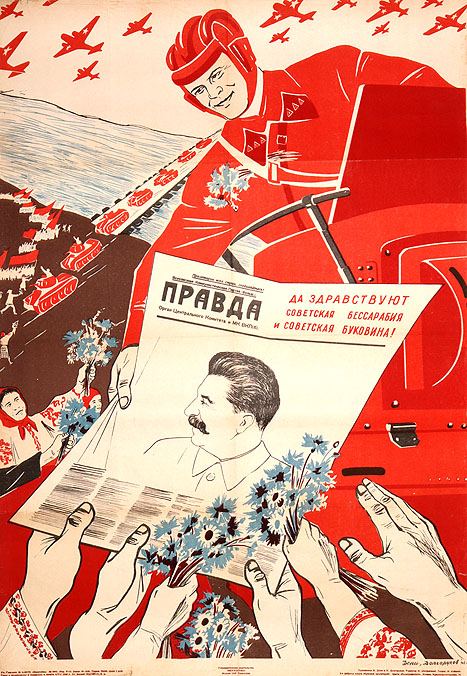
Long live Soviet Bessarabia and Soviet Bukovina!
Poster Number: PP 1204
Category: Military
Poster Notes: Although officially part of Romania since 1918, the USSR never recognized Romania’s claim to Bessarabia. After the German-Soviet Nonaggression Pact of 1939, the USSR gave an ultimatum to Romania to relinquish Bessarabia and the northern section of Bukovina. The Romanian government capitulated to the demand and the USSR annexation of Bessarabia and Bukovina took place from June 28 to July 4, 1940. Thereafter, the Moldavian Soviet Socialist Republic (Moldavian SSR) was formed and Chişinău became its capital city. Additionally, one of Bessarabia's coastal river plains was incorporated into the Ukrainian SSR. During World War II, Romania re-claimed Bessarabia for a short period but the USSR re-annexed the land in 1944. The Moldavian SSR became independent in August 1991.
Media Size: 29.5x20.5
Poster Type: Lithograph
Publishing Date: 1940
Print Run: 75,000
Catalog Notes: PP 1204 Military c
USSR Region: Moldavian SSR
Artist: Deni (Denisov), Viktor Nikolaevich — Дени (Денисов), Виктор Николаевич
Although known for his characterizations and posters that he signed with the pseudonym 'Deni'; Viktor Nikolayevich Denisov never received formal artistic education. Around 1906, Deni began exhibiting at the annual exhibitions of the Society of Independents in Saint Petersburg, as well as at the Salon of Humorists. In 1910, he took private lessons in painting and drawing from the artist-portraitist Nikolai P. Ulianov and that same year, he became active in the field of political caricature, contributing ...
Read More About This Artist
Artist: Dolgorukov, Nikolai Andreevich — Долгоруков, Николай Андреевич
In 1928, Nikolai Andreevich Dolgorukov moved from his native Ekaterinburg to Moscow to attend VKhUTEIN (Higher State Artistic and Technical Institute). After that organization dissolved in 1930, Dolgorukov continued his studies at the Moscow Polygraphic Institute under the tutelage of artists Lev Bruni and Dimitri Moor. Dolgorukov's training was in illustrated political satire as well as in poster design, and each area became the main focus of his long career. After graduation, he collaborated with fellow poster ...
Read More About This Artist
Printer: 3rd Krasnii Proletarii (Red Proletarian) Typography Workshop of Poligrafkniga, Moscow — 3-я типография Красный пролетарий Полиграфкнига, Москва
The Krasnii Proletarii Workshop originated under the ownership of Ivan Kushnerev, a Russian entrepreneur who founded the Kushnerev & Company Printing Shop in 1869 in Moscow. When Kushnerev died in 1896, his printing operation was one of the largest in Imperial Russia. In 1919, the printer was nationalized by the Soviets and consigned to the Printing Section of the Moscow Economic Council (MSNKh).) It later became the 3rd Krasnii Proletarii Book Printing Plant when its location (at 16 Pimenovskaia ...
Read More About This Printer
Publisher: Iskusstvo (Art Publishing House), Moscow-Leningrad — Искусство, Москва-Ленинград
Iskusstvo was the Art Publishing House (A.K.A. Visual Arts Publishing) that was created in 1936 from Ogiz-Izogiz (State Art and Literature Publishing House). It disseminated books and journals dealing with graphic design and the fine arts, and it issued numerous posters. Since the Iskusstvo banner was part of the State Printing Works in Leningrad (St. Petersburg) and Moscow, its two main offices were located in those two cities.
Read More About This Publisher